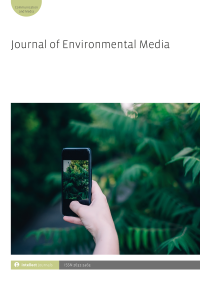- Home
- A-Z Publications
- Journal of Environmental Media
- Previous Issues
- Volume 1, Issue 1, 2020
Journal of Environmental Media - Volume 1, Issue 1, 2020
Volume 1, Issue 1, 2020
- Editorial
-
- Articles
-
-
-
From digital solutionism to materialist accountability: The urgency of new interventions
More LessBy Adi KuntsmanHow to reconcile the usefulness of digital tools and their adoption into environmental initiatives and sustainability projects, with the extensive environmental damages of the digitization itself? Despite a growing number of critical voices, pointing to environmental footprints of digital communication and the systemic blindness towards those in media analysis, the subject still remains on the margins of media studies. This article suggests reorienting the field towards materialist accountability: placing the analysis of digital harms geographically and historically; examining the silences and erasures of our own scholarship; being attentive to which technologies, and where, are inflicting harm on who; and asking what is our own responsibility as privileged media users in industrialized nations.
-
-
-
-
Digital cultures and climate change: ‘Here and now’
More LessWe are living through momentous times as we confront issues surrounding digital cultures and communications about climate change. There is urgency derived from our recognition that climate change is ‘here and now’. Inequalities of power and access – in both digital cultures and in a changing climate – disadvantage individuals and communities who seek to take actions in the face of climate threats. Via digital cultures, creativity is expanding rather than retracting from the challenge of meeting people where they are on climate change in the twenty-first century. Amid signs of progress and hope, there is much more work to be done.
-
-
-
Media life in the Anthropocene
More LessThis short article focuses on the interrelation of two seemingly invisible phenomena that have a growing influence on our daily lives: on the one hand, our intimate relationship with devices and practices mediated by technology, which make up our media life, and on the other, the great impact that our way of life has on the planet that we inhabit, which invites us to think about our role in the Anthropocene, a new geological era in which human activity is the main agent of change in the Earth’s ecosystems. Regarding these key trends as closely connected gives us the opportunity to find accessible solutions to our daily concerns on environmental issues. In other words, considering our media life in the Anthropocene means to be aware of the challenges that we face while asking ourselves how to claim a responsible use of technology that – in line with our humanity – will help us to confront them.
-
-
-
Green living and the social media connection: The relationship between different media use types and green lifestyle politics among young adults
More LessToday, environmental issues are not only communicated by traditional mass media, but they are also posted, shared and discussed in social media. This raises the question of the extent to which social media use also influences real environmental engagement. Using original survey data collected among young adults in Germany, this study demonstrates that social media use is clearly associated with stronger engagement in green lifestyle politics. Further, regarding different motives and forms of social media use, the findings of the study show that active use of social media for informational purposes predicts green lifestyle politics.
-
-
-
Between crisis and care: Projection mapping as creative climate advocacy
More LessAt this critical crossroad of climate crisis, environmental advocates have turned to projection mapping (also known as ‘guerrilla projections’, ‘digital graffiti’, etc.) to foster an ethic of care. This article focuses on two 2015 projection mapping events: one in Vatican City and the other in Paris. Although imperfect, projection mapping may orient attention, transform locations into public spaces for political engagement and cultivate collective imaginaries. By rethinking environmental media between climate crisis and care, we may define the agenda of this journal as not only centred on critique but also regenerating creative communication for a just and vibrant future.
-
-
-
Visualizing climate change in the Arctic and beyond: Participatory media and the United Nations Conference of the Parties (COP), and interactive Indigenous Arctic media
More LessAuthors: Scott MacKenzie and Anna Westerstahl StenportImpactful communication remains a vexing problem for climate science researchers and public outreach. This article identifies a range of moving images and screen-based media used to visualize climate change, focusing especially on the Arctic region and the efforts of the United Nations. The authors examine the aesthetics of big data visualization of melting sea ice and glaciers made by NASA and similar entities; eye-witness, expert accounts and youth-produced documentaries designed for United Nations delegates to the annual COP events such as the Youth Climate Report; Please Help the World, the dystopian cli-fi narrative produced for the UN’s COP 15; and Isuma TV’s streaming of works by Indigenous practitioners in Nunavut.
-
-
-
Imaging global communications: An ecocritique
More LessBy Sean CubittThrough an overview of historical medals, logos, poems, paintings and engravings, imagery that picks at the gap between the persistence of the local and the deracination of the global enterprise, the article focuses on the visual imaginaries employed to mythologize and to make sense of the reach and power of global media, noting in particular the reduction of land and sea to blank canvases on which communication media superimpose their networks. The article serves as a genealogy of Internet cartography and infographics, attending to the problematic relations between text, numbers, diagrams and pictures and their displacement of environments and localities.
-
- Reviews
-
Volumes & issues
Most Read This Month


